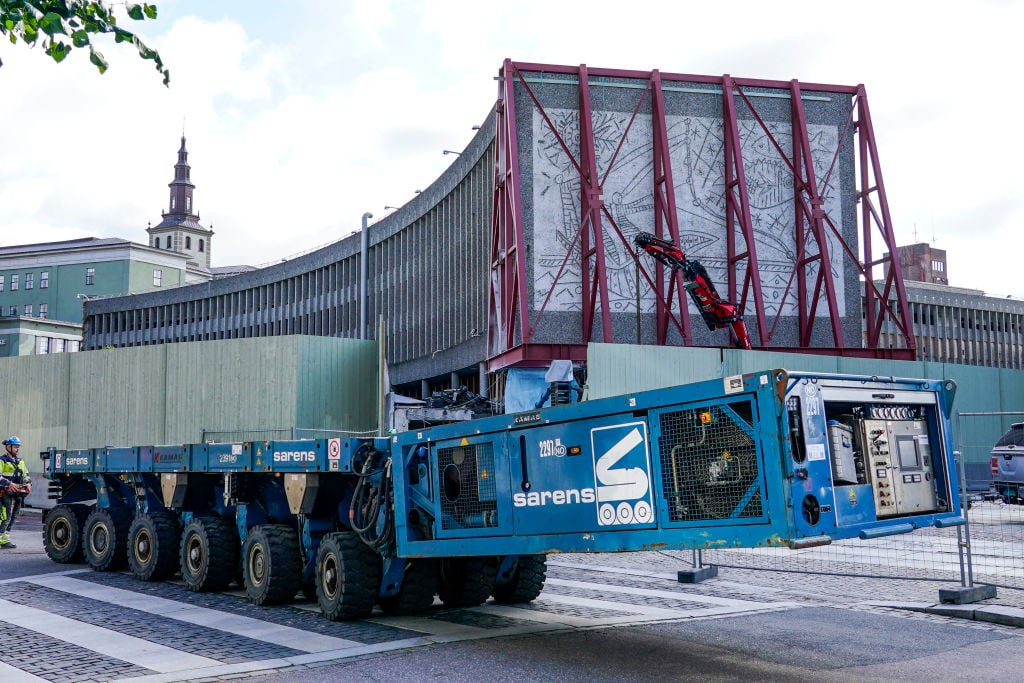
Two massive concrete murals designed by Picasso have been removed from their original home in Oslo after years of debate over their fate, which is inextricably linked to a 2011 terrorist attack in the Norwegian city.
Beginning Monday, July 27, the Norwegian government began to deconstruct the landmark Y Building, which housed the two murals: a 250-ton concrete sandblasted design on the facade called The Fishermen and, in the lobby, a 60-ton sister piece called The Seagull. Both were created by Picasso together with the Norwegian sculptor Carl Nesjar.
The works will be stored on site while the low-lying structure is torn down to make way for a modern glass building. They will eventually be reinstalled in the new facility, which is expected to be complete in 2025.
Opponents of the demolition say that as site-specific works, the murals cannot be separated from their context without fundamentally altering their character. Mari Hvattum, a professor of architectural history and theory at the Oslo School of Architecture and Design, tells Artnet News the demolition is “a massive mistake,” adding that “the relocation of Picasso’s artworks will do nothing to rectify this mistake.”
Those who support their removal argue the demolition is necessary for the safety of the site, which is located directly on top of a traffic tunnel. The former home of the country’s education ministry and other government offices has been vacant since July 2011, when right-wing extremist Anders Breivik detonated a bomb nearby, killing eight people. (Breivik went on to kill another 77 individuals on the island of Utøya, leading to Norway’s deadliest peacetime atrocity.)
The original 1969 structure was nicknamed Y Building for its shape when seen from an aerial view. During construction of the new building, The Fishermen will remain on display elsewhere in the government complex while The Seagull will be in a climate-controlled storage. It took an hour and a half to move the fragile Seagull just 0.06 miles.
Einar Gerhardsen’s place showing where Pablo Picasso’s The Fishermen will be installed as of 2025. Architect: Urbis team. Courtesy Urbis and Staatsbygg.
The fate of the murals has sparked international attention. This past spring, top curators from the Museum of Modern Art in New York wrote a letter to Norwegian officials asking them to reconsider the demolition plan, which they said “would not only constitute a significant loss of Norwegian architectural heritage, but it would also render any attempt to salvage or reposition Picasso’s site-specific murals elsewhere unfortunate.” (A representative for MoMA did not immediately respond to a request for comment about the demolition.)
Meanwhile, a petition signed by more than 60,000 people protesting the removal of the murals was still accruing signatures by publishing time. Around five protesters demonstrated against the demolition in person on Tuesday, according to a representative of the Norwegian Directorate of Public Construction and Property, which is in charge of the renovation project.
Singer-songwriter Elvira Nikolaisen, who publicly opposed the demolition, told Reuters on Monday: “There is a grieving process that this is happening. At the same time, the spirit that many displayed to campaign to protect the building has been very positive. People have woken up to the value of this art.”
Some see the late 1960s buildings, which are made with natural concrete to weather Norway’s extreme climate, as an important piece of architectural history as well as symbols of social democracy, which they argue is precisely what Breivik was attempting to destroy when he detonated bombs outside the buildings.
“He wanted to get rid of the legacy of social democracy in built form, and in living form, in terms of people,” architectural scholar Mari Hvattum told the New York Times in 2017 when the government first decided to move forward with the demolition plan. “To tear this down is to complete his mission.”
The building’s murals represent a trans-European artistic project: a similar frieze exists in Barcelona at the College of Architects of Catalonia’s building that was also drawn up by the Spanish artist and executed by Nesjar.
“I am glad we can take care of this art in this way,” Hege Njaa Aschim, communications director at the Norwegian Directorate of Public Construction and Property, said in a statement. “The 2011 bombing changed the world. We need to think about a new world now.”